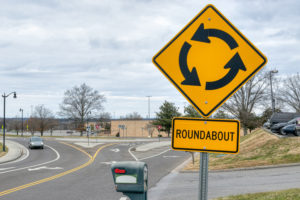Avoiding Roundabout Accidents

A “roundabout,” sometimes referred to as a traffic circle, is a circular intersection designed to improve traffic flow. Drivers enter the roundabout, drive around a center island in a counterclockwise direction, and exit at the desired street, commonly streets on the right and left, streets that continue in the same direction the roundabout was entered into, or streets going in the opposite direction, essentially creating a u-turn. Roundabouts are designed to keep traffic moving smoothly and reduce congestion and prevent serious accidents.
Roundabouts are very common in Europe but are gaining traction here in the U.S. According to the U.S. Department of Transportation’s Federal Highway Administration (FHWA), there has been a 90% decrease in fatalities and a 75% decrease in injuries nationwide, caused by 35% fewer accidents in traffic circles than at typical intersections. If you have been injured or a loved one has been killed because of an automobile or trucking accident at a roundabout, contact a Florida auto accident attorney at Searcy Denney for help with your insurance and legal claims.
What Can I Do to Avoid Roundabout Accidents in Florida?
Like most traffic accidents, there are a few safety tips that drivers should follow to avoid roundabout accidents, including:
- Watch for Pedestrians. Before entering or merging into a roundabout, look to be sure that pedestrians aren’t crossing at the same time. While typical intersection crosswalks are precisely at the turn points, roundabout crosswalks are located several feet in front of the byway.
- Pay Attention to Your Lanes. Before merging into the roundabout, be sure you’re entering the lane appropriate for your anticipated exit. Exit lanes separate from the circle depending on the street you’re exiting onto. Most lanes are clearly marked for specific exits, so it’s best to enter the roundabout in the correct lane for your eventual exit. Many roundabouts are single-lane, while others have as many as three lanes, and you usually aren’t supposed to change lanes in the middle of the circle. For roundabouts with two or more lanes, (1) remain in the right lane to exit right or to continue straight, and use the left or inner lane to go straight, turn left or make a U-turn.
- Use Your Signals. Use your blinkers to signal that you’re getting off when you are approaching your exit. Signaling your intention allows drivers behind you to adjust accordingly.
- Reduce your Speed. Roundabouts always work better when everyone slows down.
- Yield, yield, yield. You can’t count on other drivers to follow the rules out of ignorance or arrogance. When in doubt, just be the adult and yield.
A Florida Auto Accident Attorney Can Help You Successfully Navigate Roundabouts
Roundabouts are relatively new traffic mechanisms and take some getting used to. If there is a roundabout near your house, it wouldn’t hurt to go practice during the late evening and teach your new driver kids with you. Nonetheless, accidents happen. By mastering the roundabout, you increase the chances that the accident will be someone else’s fault. If this is the case, a Florida auto accident attorney can help. We work on a contingency fee basis, so contact us to discuss your claims during your free consultation.
Share This


